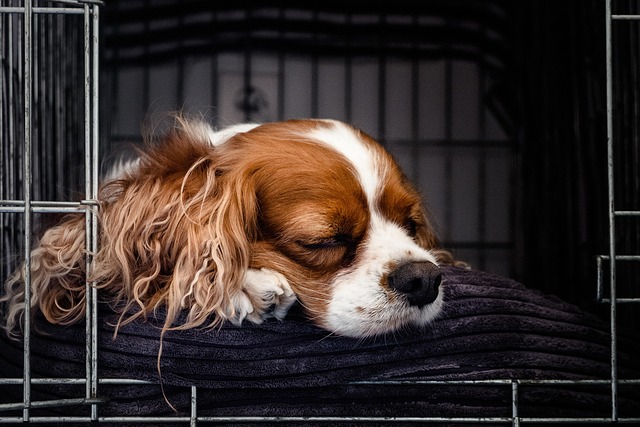Bringing home a new puppy? One of the most helpful skills you can teach him right from the start is how to love his crate. Crate training isn’t just about house training — it gives your pup a safe, cozy den of his own and helps keep him (and your home!) protected when you can’t supervise him.
Here’s everything you need to know to crate train your puppy with confidence.
What Is Crate Training?
Crate training teaches your puppy to view a crate as a calm, comfortable, happy place — not a punishment. By using positive reinforcement, your pup learns that the crate is his personal den for napping, relaxing, sleeping and staying safe when you step out for short periods.
A crate-trained puppy is easier to house train, safer when you’re not home and more comfortable in situations like traveling, vet visits or recovery from surgery. It also provides structure that helps him adjust to his new life with you.
Why Crate Training Is So Helpful
For young puppies, crate training is an enormously useful tool. It can help with:
- House training and bladder control
- Keeping your puppy safe (no chewing cords or furniture)
- Preventing accidents when you're away or distracted
- Traveling safely
- Managing behaviors like separation anxiety
There are plenty of real-life situations where crate training comes in handy:
- A visitor is afraid of dogs
- Your puppy needs rest after surgery
- He’s prone to chewing everything in sight
- He panics when left alone and may hurt himself
A crate gives him a safe, secure space when he needs it most.
Choosing the Right Crate for Your Puppy
There are lots of crate styles, but for training a young pup, the best choices are:
- Wire crates
- Plastic crates with a wire door
Fabric crates aren’t recommended for puppies — they can be easily chewed through.
Picking the right size
Your pup should be able to stand up and turn around, but that’s it. A crate that’s too big can encourage accidents.
For a growing puppy, choose a crate with a divider panel so you can adjust the space as he grows without buying multiple crates.
Recommended Puppy Crates

Revol Dog Crate
A sturdy, thoughtfully designed crate with safety features perfect for curious puppies. It includes a divider and a side “garage-style” door for versatility.

MidWest iCrate Folding Metal Dog Crate
A classic, reliable wire crate with an adjustable divider — great for puppies who will grow into a larger adult size.
How To Crate Train Your Puppy Step by Step
1. Meet your puppy’s needs first
Before crate time, make sure he’s:
- Had a potty break
- Burned off some energy
- Had mental stimulation
A puppy who needs to pee or is full of zoomies won’t relax in a crate.
2. Make the crate irresistible
Start building positive associations by loading the crate with exciting things while your puppy watches — then close the door.
Use:
- Favorite toys
- High-value treats
- Chews
Let him sniff around and see all the goodies he wants but can’t reach yet. This builds motivation.
3. Open the door and let him choose to go in
When he’s pawing, sniffing or showing interest, open the door and let him enter on his own.
Don’t push or force him. Prop the door open so he can explore freely.
If he leaves, close the door and “reset” by adding more treats. Let him choose to go back in again. Repeat until he’s excited to enter the crate.
4. Close the door (but don’t lock it yet)
Once he’s comfortable staying inside, gently close the door for short periods — still without locking it.
If he wants to come out, no problem. Just close the door behind him and reload with treats so the crate is always the more appealing option.
When he’s happily staying inside with the door closed, start locking it for short periods while providing a longer-lasting chew (like a stuffed KONG).
5. Practice leaving the room
When he can relax in the crate for a few minutes, start leaving him alone for quick tasks:
- Taking out the garbage
- Getting a drink
- Stepping into another room
He’ll learn that you always come back — and that crate time isn’t a big deal.
Work up to leaving him in the crate for the length of time he can comfortably hold his bladder. Start with about two hours and slowly increase to four.
Using the Crate for Potty Training
Once your puppy feels safe in the crate, you can use it to help teach house training.
When you’re home but can’t watch him, even for a second, he should go in the crate. This prevents accidents and helps him learn bladder control.
Take your puppy outside often
During training, bring him out every 1–2 hours. Always reward him immediately after he pees while you’re still outside.
And remember to take him out:
- First thing in the morning
- Right before bed
- After naps
- After meals
- After playtime
If Your Puppy Has an Accident Indoors
If you catch him mid-accident:
Make a gentle noise to interrupt (a clap works), then quickly bring him outside to finish. Praise and reward if he goes.
No scolding — it will only teach him to hide his accidents.
If you find it later:
Just clean it thoroughly with an enzyme cleaner so he doesn’t return to the same spot.
Try: Rocco & Roxie Stain & Odor Eliminator
Be Patient — With Your Puppy and Yourself
Accidents are normal. Setbacks are normal. Crate training is a gradual process, but with consistency and positive reinforcement, your puppy will learn quickly.
If you need help or if training feels overwhelming, don’t hesitate to reach out to a veterinarian or a certified dog behavior professional.
We independently pick all the products we recommend because we love them and think you will too. If you buy a product from a link on our site, we may earn a commission.











